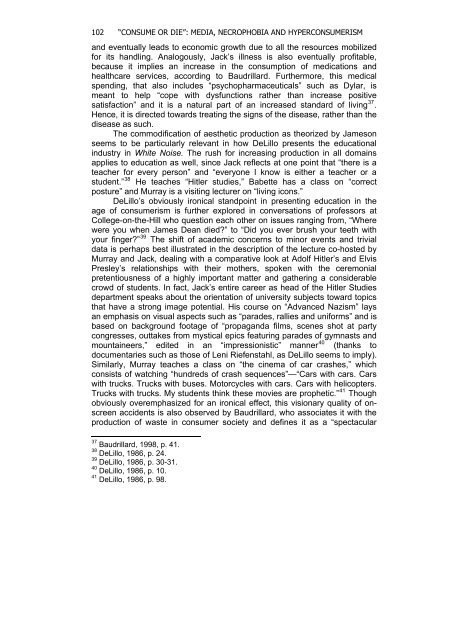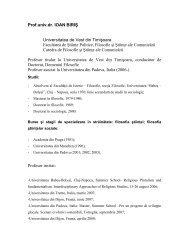VOL. IV (XXI) 2009 - Departamentul de Filosofie si Stiinte ale ...
VOL. IV (XXI) 2009 - Departamentul de Filosofie si Stiinte ale ...
VOL. IV (XXI) 2009 - Departamentul de Filosofie si Stiinte ale ...
Create successful ePaper yourself
Turn your PDF publications into a flip-book with our unique Google optimized e-Paper software.
102 “CONSUME OR DIE”: MEDIA, NECROPHOBIA AND HYPERCONSUMERISM<br />
and eventually leads to economic growth due to all the resources mobilized<br />
for its handling. Analogously, Jack’s illness is also eventually profitable,<br />
because it implies an increase in the consumption of medications and<br />
healthcare services, according to Baudrillard. Furthermore, this medical<br />
spending, that also inclu<strong>de</strong>s “psychopharmaceuticals” such as Dylar, is<br />
meant to help “cope with dysfunctions rather than increase po<strong>si</strong>tive<br />
satisfaction” and it is a natural part of an increased standard of living 37 .<br />
Hence, it is directed towards treating the <strong>si</strong>gns of the disease, rather than the<br />
disease as such.<br />
The commodification of aesthetic production as theorized by Jameson<br />
seems to be particularly relevant in how DeLillo presents the educational<br />
industry in White Noise. The rush for increa<strong>si</strong>ng production in all domains<br />
applies to education as well, <strong>si</strong>nce Jack reflects at one point that “there is a<br />
teacher for every person” and “everyone I know is either a teacher or a<br />
stu<strong>de</strong>nt.” 38 He teaches “Hitler studies,” Babette has a class on “correct<br />
posture” and Murray is a vi<strong>si</strong>ting lecturer on “living icons.”<br />
DeLillo’s obviously ironical standpoint in presenting education in the<br />
age of consumerism is further explored in conversations of professors at<br />
College-on-the-Hill who question each other on issues ranging from, “Where<br />
were you when James Dean died?” to “Did you ever brush your teeth with<br />
your finger?” 39 The shift of aca<strong>de</strong>mic concerns to minor events and trivial<br />
data is perhaps best illustrated in the <strong>de</strong>scription of the lecture co-hosted by<br />
Murray and Jack, <strong>de</strong>aling with a comparative look at Adolf Hitler’s and Elvis<br />
Presley’s relationships with their mothers, spoken with the ceremonial<br />
pretentiousness of a highly important matter and gathering a con<strong>si</strong><strong>de</strong>rable<br />
crowd of stu<strong>de</strong>nts. In fact, Jack’s entire career as head of the Hitler Studies<br />
<strong>de</strong>partment speaks about the orientation of univer<strong>si</strong>ty subjects toward topics<br />
that have a strong image potential. His course on “Advanced Nazism” lays<br />
an empha<strong>si</strong>s on visual aspects such as “para<strong>de</strong>s, rallies and uniforms” and is<br />
based on background footage of “propaganda films, scenes shot at party<br />
congresses, outtakes from mystical epics featuring para<strong>de</strong>s of gymnasts and<br />
mountaineers,” edited in an “impres<strong>si</strong>onistic” manner 40 (thanks to<br />
documentaries such as those of Leni Riefenstahl, as DeLillo seems to imply).<br />
Similarly, Murray teaches a class on “the cinema of car crashes,” which<br />
con<strong>si</strong>sts of watching “hundreds of crash sequences”—“Cars with cars. Cars<br />
with trucks. Trucks with buses. Motorcycles with cars. Cars with helicopters.<br />
Trucks with trucks. My stu<strong>de</strong>nts think these movies are prophetic.” 41 Though<br />
obviously overempha<strong>si</strong>zed for an ironical effect, this vi<strong>si</strong>onary quality of onscreen<br />
acci<strong>de</strong>nts is also observed by Baudrillard, who associates it with the<br />
production of waste in consumer society and <strong>de</strong>fines it as a “spectacular<br />
37 Baudrillard, 1998, p. 41.<br />
38 DeLillo, 1986, p. 24.<br />
39 DeLillo, 1986, p. 30-31.<br />
40 DeLillo, 1986, p. 10.<br />
41 DeLillo, 1986, p. 98.




